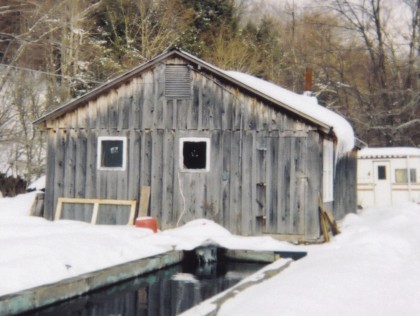Historically,
land-locked Atlantic salmon abounded in the
area prior to
the early 1800’s. Professor Dwight Webster from
Cornell University wrote a paper, referencing the abundance of Atlantic
salmon in Central New York.
Another
early account is found in the Van der Kemp Papers and pertains to the
year 1792
"Both
Salmon Rivers, emptying into Lake Ontario ... and the Fish-creek in
Oneyda lake are in the spring and fall [full] of Salmon. You
may form of this assertion, a pretty accurate opinion after I have
informed you, that one Oneyda Indian took with his Spear 45 Salmons
within an hour; another in the presence of Captain Simonds 65 during
one night, and another 80" (Van Der Kemp, 1880:64).
Atlantic
salmon used to
run up the Oswego River each year into Onondaga Creek, the Seneca and
Oneida Rivers as well as Oneida, Cayuga and Seneca
Lakes. Each year members of the Oneida Nation would
gather for a ritualized salmon feast at the junction of the East and
West Branch of Fish Creek. They would trap and harvest
thousands of Atlantic salmon in weirs. The salmon would be
dried and smoked on racks for their winter sustenance.
Native
Americans had a
fishing village called Kuh-na-ta-ha located where the village of
Phoenix is now according to Father Le Moyne. The name meant
“Place of Tall Pines”. Another
Native American fishing village (T’kah-koon-goon-da-nah-yea)
was located at Caughdenoy. A 1794 map shows an Indian
fishing village near the confluence of the Fish Creek’ east
and west branches.
Sadly, dams built in the Oswego and Seneca Rivers stopped the annual
salmon migration upstream from Lake Ontario. Several times in
the early 1800’s deputations of the Oneida Nation travelled
to Albany to complain about the decline of Lake Ontario’s
salmon runs caused by dam building.
Again from Webster’s article:
"Salmon
frequented this lake [Cayuga] the latter end of August and
continued until cold weather. Last year [1809, since the erection of
Baldwin's mill dam across the Seneca River, they did not appear until
October, and then not in the usual number. Some have always
continued over the winter, and are caught by openings in the ice, with
a hook and a bait of pork or white worm" (p 162).
Atlantic salmon vanished from Lake Ontario shortly after 1850 according
to Webster. |


